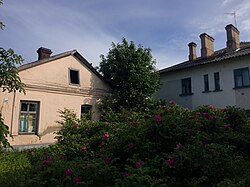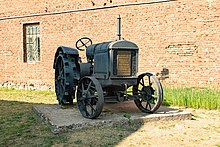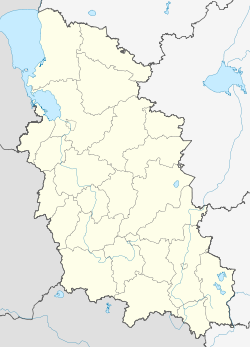Gdov
Gdov
Гдов | |
|---|---|
 | |
| Coordinates:58°44′N27°50′E/ 58.733°N 27.833°E | |
| Country | Russia |
| Federal subject | Pskov Oblast[1] |
| Administrative district | Gdovsky District[1] |
| First mentioned | beginning of the 14th century[2] |
| Town status since | 1780[3] |
| Elevation | 40 m (130 ft) |
| Population | |
| • Total | 4,379 |
| •Capitalof | Gdovsky District[5] |
| •Municipal district | Gdovsky Municipal District[6] |
| •Urban settlement | Gdov Urban Settlement[6] |
| •Capitalof | Gdovsky Municipal District,[7]Gdov Urban Settlement[6] |
| Time zone | UTC+3(MSK |
| Postal code(s)[9] | 181600 |
| Dialing code(s) | +7 81131 |
| OKTMOID | 58608101001 |

Gdov(Russian:Гдов) is atownand theadministrative centerofGdovsky DistrictinPskov Oblast,Russia,located on the riverGdovka,just 2 kilometers (1.2 mi) from its outflow intoLake Peipus.Population:3,465 (2021 Census);[10]4,379 (2010 Russian census);[4]5,171 (2002 Census);[11]6,009 (1989 Soviet census).[12]
History
[edit]It was first mentioned in the beginning of the 14th century, as an outpost guarding the city ofPskov.[2]Between 1431 and 1434, Pskovians built afortressthere,[2]the remains of which can still be seen. It was attacked on numerous occasions by theSwedesand thePolish-Lithuanian Commonwealth[2](e.g., during theRusso–Swedish War (1590–1595)and theIngrian War), and captured by the Swedes in 1614, but was finally returned to Russia in 1617 according to theTreaty of Stolbovo.[13]
In the course of theadministrative reformcarried out in 1708 byPeter the Great,Gdov was made a part of Ingermanland Governorate (known since 1710 asSaint Petersburg Governorate).[14]Gdov was mentioned as one of the towns into which the governorate was divided.[14]In 1780, Gdov was granted town status;[3]itscoat of armswas granted on May 28, 1781.[2]Between 1874 and 1912, Gdov issuedZemstvo stamps.The first stamp, worth twokopecks,appeared on April 16, 1874. Stamp production ceased, however, with the coming ofWorld War I.In 1919, Gdov was an area where important events of theRussian Civil Warand theEstonian War of Independencetook place. Originally, the area east ofLake Peipuswas under control of the revolutionary government. On May 15, 1919, the detachment under command ofStanisław Bułak-Bałachowicz(subordinate to GeneralAleksandr Rodzyanko) captured Gdov and the wholeuyezdthus came under control by the White Army troops ofNikolai Yudenich.In November 1919, theRed Armyrecaptured Gdov.[15]
On August 1, 1927, theuyezdsand governorates were abolished and Gdovsky District, with theadministrative centerin Gdov, was established as a part ofLuga OkrugofLeningrad Oblast.[16][17]It included parts of former Gdovsky Uyezd.[17]On July 23, 1930, theokrugswere also abolished and the districts were directly subordinated to theoblast.[16]Between March 22, 1935 and September 19, 1940, Gdovsky District was part of the restoredPskov Okrugof Leningrad Oblast,[16]one of theokrugsabutting the state boundaries of the Soviet Union.
Between July 19, 1941 and February 4, 1944, Gdov was occupied byGermantroops andWaffen SSunits from occupiedEstonia.During the war two-thirds of Gdov's population died. The town was seriously damaged during the war; of 640 buildings that existed in 1941, all but 34 were destroyed. Most of the devastation occurred just before the Nazi retreat on January 28, 1944, when the 37th SS police battalion formed in Tartu[18]set wooden buildings on fire and set explosives into those of stone. Among the destroyed historical buildings was the unique ensemble of two 15th and 16th-century churches that survived the Bolshevik anti-religion campaigns.[19][20]
On August 23, 1944, the district was transferred to the newly established Pskov Oblast.[17]The town was reconstructed during the 1950s and 1960s and continued to expand until the economic and demographic collapse of the early 1990s. In 1993 an exact copy of St. Dmitry Solounskiy church was built at its original location at theGdov Kremlin,financed exclusively by crowdfunding.[19]
Administrative and municipal status
[edit]Within theframework of administrative divisions,Gdov serves as theadministrative centerofGdovsky District,[5]to which it is directly subordinate.[1]As amunicipal division,thetownof Gdov, together with sixty-two rural localities, is incorporated within Gdovsky Municipal District asGdov Urban Settlement.[6]
Economy
[edit]
Industry
[edit]The economy of Gdov is based on the food and timber industries.[21]
Transportation
[edit]

A railway line via Gdov connecting Narva and Pskov was built before WWI. Later a new line from Gdov toSlantsyandVeimarnwas constructed and used for passenger and cargo connections to Leningrad. During WWII the Gdov–Pskov stretch was destroyed, thus making Gdov the terminal station. There was one pair of passenger trains daily servicing the St. Petersburg–Gdov route. In the mid-2010s, passenger traffic between Slantsy and Gdov was discontinued for commercial reasons. The railway between Slantsy and Gdov was deserted and, as of 2021, mainly demolished.[22]
Between the 1950s and 1980s an unpavedairfieldin Gdov[23]was used for commuter air transit to the neighbouring towns of Slantsy, Pskov and Tartu aboard anAn-2passenger biplane.
Gdov is connected by paved roads to Pskov,Kingiseppvia Slantsy, andPlyussa.There are daily bus services to Pskov, Slantsy, Saint-Petersburg, and neighbouring villages.
In the mouth of theGdovkathere is a harbour for fishing and leisure boats. However, due to the lack of customs and border guard offices, sailing to Estonia is not possible.
Military installations
[edit]DuringWorld War IIGdov briefly hosted the headquarters of the Chudskoye Lake Flotilla (1941).[24]
TheRussian AirforcebaseSmuravyevo,now abandoned, was located northeast of the town.
Restricted access
[edit]Gdov is included in theborder security zone,intended to protect theborders of Russiafrom unwanted activity.[25]Visits to the zone or transit through it are subject to the Frontier Regime Regulations set by theFSBthat stipulate cases where permits are required or where holding a passport is enough.[26]Permits may be obtained electronically via e-mail, four weeks ahead of the planned journey.[27]
Culture
[edit]

Gdov contains two cultural heritage monuments of federal significance and additionally twelve objects classified as cultural and historical heritage of local significance.[28]The federal monuments are archaeological sites. Gdov has akremlin,an ancient fortress built in the 14th century. Only fragments of the original fortress walls have survived. TheSt. Dimitry Solounskiy Cathedralwas destroyed in 1944 and reconstructed in 1993.
The only state museum in the district is theGdov Museum of Regional History.It was founded in 1919, destroyed during the German occupation of Gdov, and rebuilt afterWorld War II.The museum hosts historical and local interest collections.[29]
Notable people
[edit]- Dmitri Iosifovich Ivanovsky(1864–1920; alternative spellingDmitriiorDmitry Iwanowski(Russian:Дми́трий Ио́сифович Ивано́вский), Russian botanist, co-discoverer of viruses (1892) and one of the founders ofvirology.
References
[edit]Notes
[edit]- ^abcdLaw #833-oz stipulates that the borders of the administrative districts are identical to the borders of the municipal districts. The Law #420-oz, which describes the borders and the composition of the municipal districts, lists the town of Gdov as a part of Gdovsky District.
- ^abcdeЭнциклопедия Города России.Moscow: Большая Российская Энциклопедия. 2003. pp. 105–106.ISBN5-7107-7399-9.
- ^ab"Гдов (Gdov)"(in Russian).Great Soviet Encyclopedia.
- ^abRussian Federal State Statistics Service (2011).Всероссийская перепись населения 2010 года. Том 1[2010 All-Russian Population Census, vol. 1].Всероссийская перепись населения 2010 года [2010 All-Russia Population Census](in Russian).Federal State Statistics Service.
- ^abГосударственный комитет Российской Федерации по статистике. Комитет Российской Федерации по стандартизации, метрологии и сертификации. №ОК 019-95 1 января 1997 г. «Общероссийский классификатор объектов административно-территориального деления. Код 58 208», в ред. изменения №278/2015 от 1 января 2016 г..(State Statistics Committee of the Russian Federation. Committee of the Russian Federation on Standardization, Metrology, and Certification. #OK 019-95 January 1, 1997Russian Classification of Objects of Administrative Division (OKATO). Code 58 208,as amended by the Amendment #278/2015 of January 1, 2016. ).
- ^abcdLaw #420-oz
- ^Федеральная служба государственной статистики. Федеральное агентство по технологическому регулированию и метрологии. №ОК 033-2013 1 января 2014 г. «Общероссийский классификатор территорий муниципальных образований. Код 58 608».(Federal State Statistics Service. Federal Agency on Technological Regulation and Metrology. #OK 033-2013 January 1, 2014Russian Classification of Territories of Municipal Formations.Code 58 608.).
- ^"Об исчислении времени".Официальный интернет-портал правовой информации(in Russian). June 3, 2011.RetrievedJanuary 19,2019.
- ^Почта России. Информационно-вычислительный центр ОАСУ РПО. (Russian Post).Поиск объектов почтовой связи(Postal Objects Search)(in Russian)
- ^Russian Federal State Statistics Service.Всероссийская перепись населения 2020 года. Том 1[2020 All-Russian Population Census, vol. 1](XLS)(in Russian).Federal State Statistics Service.
- ^Federal State Statistics Service(May 21, 2004).Численность населения России, субъектов Российской Федерации в составе федеральных округов, районов, городских поселений, сельских населённых пунктов – районных центров и сельских населённых пунктов с населением 3 тысячи и более человек[Population of Russia, Its Federal Districts, Federal Subjects, Districts, Urban Localities, Rural Localities—Administrative Centers, and Rural Localities with Population of Over 3,000](XLS).Всероссийская перепись населения 2002 года [All-Russia Population Census of 2002](in Russian).
- ^Всесоюзная перепись населения 1989 г. Численность наличного населения союзных и автономных республик, автономных областей и округов, краёв, областей, районов, городских поселений и сёл-райцентров[All Union Population Census of 1989: Present Population of Union and Autonomous Republics, Autonomous Oblasts and Okrugs, Krais, Oblasts, Districts, Urban Settlements, and Villages Serving as District Administrative Centers].Всесоюзная перепись населения 1989 года [All-Union Population Census of 1989](in Russian). Институт демографии Национального исследовательского университета: Высшая школа экономики [Institute of Demography at the National Research University: Higher School of Economics]. 1989 – viaDemoscope Weekly.
- ^Столбовский мир 1617(in Russian).Great Soviet Encyclopedia.RetrievedJune 19,2020.
- ^abУказ об учреждении губерний и о росписании к ним городов(in Russian)
- ^Ратьковский, И.С.; Ходяков М. В. (2001).История Советской России(in Russian). Лань.RetrievedJune 23,2014.
- ^abcAdministrative-Territorial Structure of Pskov Oblast,pp. 11–13
- ^abcГдовский район (август 1927 г. - август 1944 г.)(in Russian). Справочник истории административно-территориального деления Ленинградской области. Archived fromthe originalon October 29, 2013.RetrievedJune 23,2014.
- ^Chuev, Sergeĭ Gennadʹevich. (2004).Проклятые солдаты[The Damned Soldiers: Traitors Serving to the Third Reich]. Moskva: Яуза.ISBN5-699-05970-9.OCLC56389355.
- ^abЗотов, Георгий (July 1, 2020)."Город мертвых церквей. Это забытое преступление – одно из тысяч в России".aif.ru.RetrievedOctober 9,2020.
- ^"Вперед, за Ленинград! Как освободили от фашистов Гдов".histrf.ru(in Russian).RetrievedOctober 9,2020.
- ^Экономика(in Russian). Портал муниципальных образований Псковской области.RetrievedMay 23,2012.
- ^Теплов, Игорь (April 14, 2021)."Кингисепп и Сланцы: кто первый встал, того и тапки".Rodina na Neve.
- ^"Карта аэродромов России".
- ^"Chudskaya Lake Flotilla".Archived fromthe originalon December 22, 2012.RetrievedMarch 13,2018.
- ^"Приказ Федеральной службы безопасности Российской Федерации от 29.12.2016 № 802" О пределах пограничной зоны на территории Псковской области "".pravo.gov.ru.Официальный интернет-портал правовой информации.RetrievedMarch 14,2018.
- ^"Приказ Федеральной службы безопасности Российской Федерации от 07.08.2017 № 454" Об утверждении Правил пограничного режима "".pravo.gov.ru.Официальный интернет-портал правовой информации.RetrievedMarch 14,2018.
- ^"Выдача пропусков в погранзону изменится с 1 января | Официальный портал государственных органов Псковской области".www.pskov.ru.RetrievedMarch 14,2018.
- ^Памятники истории и культуры народов Российской Федерации(in Russian). Russian Ministry of Culture.RetrievedJune 2,2016.
- ^Гдовский музей истории края(in Russian). Российская сеть культурного наследия. Archived fromthe originalon July 16, 2012.RetrievedMay 21,2012.
Sources
[edit]- Псковское областное Собрание депутатов. Закон №833-оз от 5 февраля 2009 г. «Об административно-территориальном устройстве Псковской области». Вступил в силу со дня официального опубликования. Опубликован: "Псковская правда", №20, 10 февраля 2009 г.(Pskov Oblast Council of Deputies. Law #833-oz of February 5, 2009On the Administrative-Territorial Structure of Pskov Oblast.Effective as of the official publication date.).
- Псковское областное Собрание депутатов. Закон №420-оз от 28 февраля 2005 г. «Об установлении границ и статусе вновь образуемых муниципальных образований на территории Псковской области», в ред. Закона №1542-ОЗ от 5 июня 2015 г. «О внесении изменений в Закон Псковской области "Об установлении границ и статусе вновь образуемых муниципальных образований на территории Псковской области" ». Вступил в силу со дня официального опубликования. Опубликован: "Псковская правда", №41–43, №44–46, №49–51, 4 марта 2005 г., 5 марта 2005 г., 11 марта 2005 г.(Pskov Oblast Council of Deputies. Law #420-oz of February 28, 2005On Establishing the Borders and the Status of the Newly Formed Municipal Formations on the Territory of Pskov Oblast,as amended by the Law #1542-OZ of June 5, 2015On Amending the Law of Pskov Oblast "On Establishing the Borders and the Status of the Newly Formed Municipal Formations on the Territory of Pskov Oblast".Effective as of the official publication date.).
- Архивный отдел Псковского облисполкома. Государственный архив Псковской области. "Административно-территориальное деление Псковской области (1917–1988 гг.). Справочник". (Administrative-Territorial Structure of Pskov Oblast (1917–1988). Reference.) Книга I. Лениздат, 1988
External links
[edit] Media related toGdovat Wikimedia Commons
Media related toGdovat Wikimedia Commons- Official website of Gdov(in Russian)
- Gdov Business Directoryjsprav.ru(in Russian)
- Architectural history of Gdov(in Russian)




